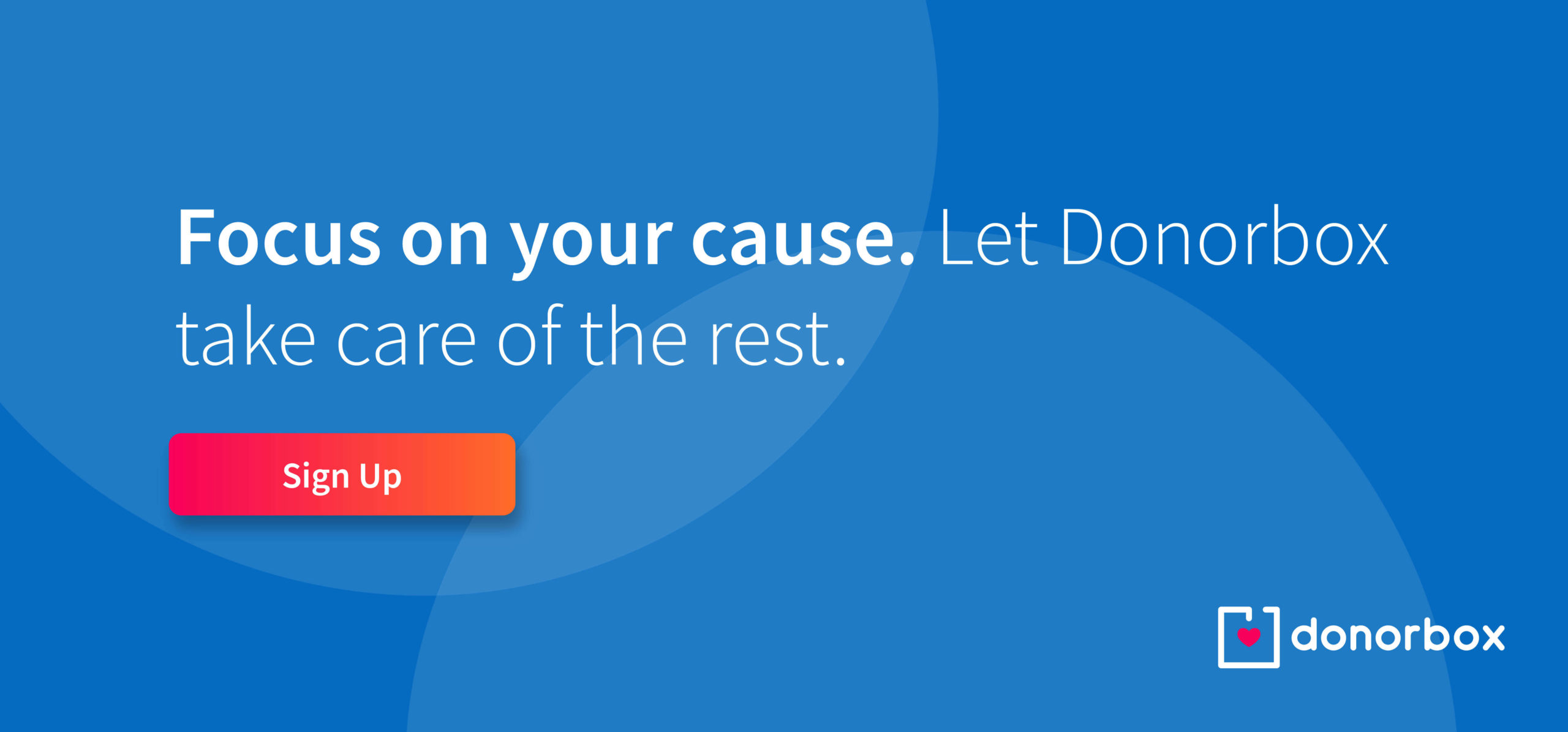When was the last time you asked your donors for input? If the answer is never, it’s time to consider sending a donor survey to get valuable feedback from those who support your organization.
Surveying your donors allows you to gain insight into their experience with your nonprofit, while also making them feel like an integral part of your organization.
In this guide, learn why and when to survey your donors, how to choose the best survey tool, and what to do with survey responses once you receive them. Plus, we’ll share tips to help you survey your donors the right way!
When Should You Survey Your Donors?
There are many reasons why a nonprofit may choose to survey donors. Ultimately, you should survey donors when you need feedback to move forward.
Here are six great opportunities to survey your donors.
1. General feedback
Obviously, a survey is great for getting a variety of feedback from your donors. A general feedback survey can help you gather information about how your mission is perceived, whether your communication strategy is effective, and any common questions your donors may have about your organization.
You can send this survey any time you need some general guidance about your nonprofit.
2. After an event
An event survey can help you gather important metrics to measure the success of your event – and it can help you plan when it comes time for your next event.
Send one a few days after so your event is still fresh in your attendees’ minds. You can include the survey in your thank-you email. Your attendees will appreciate the chance to share their feedback!
Pro tip: Donorbox Events helps you stay in touch with your attendees with comprehensive event ticketing pages. Collect all the information you need from your supporters, including contact info!
Need some inspiration? Here are 12 post-event survey questions to ask! We also have a free post-event survey template to help you get started.
3. New membership program
Are you ready to launch a new membership program but aren’t sure how to structure it or what benefits to include? Surveying your existing donors can help you determine what your potential members would want to see in a membership offering.
Ask some multiple-choice questions about membership tier pricing and types of benefits, but be sure to include some open-ended questions as well.
Do you already have a membership program? You can survey your current members to see how satisfied they are and if there’s anything you can do differently. Check out these seven proven ways to retain and recruit members!
4. Measuring a campaign’s success
If your organization has just completed a major fundraising effort like a capital campaign, surveying donors can help you measure the success of your campaign’s outreach.
You can segment your survey audience into the following categories:
- New donors who gave to this campaign
- Existing donors who gave to this campaign
- Existing donors who didn’t give to this campaign
Each of these groups can share valuable insight into your outreach and messaging strategies. This information will be invaluable when you plan your next major campaign.
Donorbox can help you pull those segmented lists! Our donor management tools make it easy to sort donors by campaign. Plus, reporting templates make pulling a New Donors report quick and simple.
From your Supporters database, select the campaigns dropdown to filter your donors by your most recent campaign. You can also exclude your most recent campaign by selecting every other campaign.

5. Reevaluating offerings
Does your organization offer programming like exhibits, classes, or performances?
Understanding what your audience is looking for can help you reevaluate your offerings for more attendance and revenue. Send a survey to your recent participants to learn about their experience, what you could do better, and which kinds of activities they would like to join in the future.
This is also a great way to grow your offerings. For example, if someone attended a writing workshop and said they were interested in a dance class in their survey response, you can include them in your next email about upcoming dance classes.
6. Making donors feel valued
Everyone wants to feel heard. Surveying your donors is a great way to show them that you care about their experience – and that you want to do better.
This helps build donor trust and increase your transparency. Plus, surveyed donors who see you actively implement their suggestions get to feel like a part of your progress, which creates stronger relationships.
Finding the Right Survey Tool
There are many survey tools on the market right now. While many of them offer similar functionality, there are a few things you should consider as you choose your tool.
1. How many survey responses do you expect?
This can be hard to estimate if this is your first time surveying your donors! The amount of responses you expect can affect the cost of your survey tool. For example, SurveyMonkey charges $25 per user per month for up to 50,000 responses a year.
If you’re only surveying your 150 event attendees, there are plenty of free options (including SurveyMonkey!) that can help you gather those responses.
2. Do you want to brand your surveys?
If you want your survey to look like the other materials you send out, you’ll need to find a tool with the option to change the appearance of your survey.
Several free tools, like Google Forms, allow you to upload a logo to your survey so your donors have that level of trust and recognition as they respond. If surveying will become a common part of your outreach, it may be worth it to invest in a branded survey template.
3. How many fields do you need?
We don’t recommend overwhelming your survey recipients with too many response fields, but you need to consider how many questions you’ll need to get the necessary information.
Some tools use the number of fields you need to determine their pricing. For example, the free version of Jotform allows up to 100 fields per form. Having an idea of how many questions you’ll need to ask before building your form can help you choose the right tool for you.
3 Tips for Surveying Your Donors
1. Review your questions
An effective survey must have clear, easy-to-understand questions. You also want to avoid leading questions that can skew your results. That’s why it’s crucial to get multiple eyes on your survey questions to ensure they make sense, aren’t too repetitive, and will lead to honest responses.
You’ll get more responses if your survey takers don’t have to spend too much time deciphering questions or providing the same information over and over. Feedback from your team will give you the perfect survey!
2. Make responses anonymous
Anonymizing survey responses can help you get more honest answers. It can also increase the number of people willing to provide a response.
Just make sure that if you’re promising anonymity, you’re really providing it! Don’t send a survey to one person and tell them it’s anonymous feedback.
3. Incentivize responses
Providing an incentive can help you get more responses. Think tickets to your next event, a gift card, or merchandise with your organization’s logo.
Just be sure to clarify the terms of the incentive! Also, reiterate that you want honest feedback – so they’ll be incentivized no matter what they share in their responses.
What to Do With Survey Responses
You’ve crafted the perfect survey and brought in some great responses…now what? Here’s what to do with the info you’ve gathered.
1. Look for trends
Try to approach your survey responses the way a data analyst might. What are the trends between responses?
If you’re looking for feedback about your latest campaign and noticed several people mentioned they didn’t donate because they didn’t know about it, you now know that you need to work on your campaign outreach next time.
2. Record the responses
Track your responses and keep them somewhere you can locate them again in the future. If your survey responses aren’t anonymous, you should also record each donor’s response in your CRM or donor management tool.
Donorbox lets you track incoming and outgoing communication so all of your donor communication information lives in one place. Simply set the channel and add any key takeaways from the supporter’s survey responses.

3. Implement changes
The best way to ensure your survey helps build stronger relationships with your donors is to implement their changes! If you receive feedback that you can improve in an area, taking real steps do to so is both the right thing to do and a great way to show donors that you care about their opinions.
Conclusion
Rarely do we get to see inside the minds of our donors. Sending a donor survey is a great way to get insight into your organization’s performance, your donor’s needs, and your next steps.
We hope these tips and tricks to create the perfect donor survey help you feel more confident reaching out to your supporters this way. Just remember that donors want you to do well – they’ve supported your cause, after all! So, they may be your best audience for providing honest, helpful feedback.
For more tips to build up your donor relationships, check out the rest of our Nonprofit Blog. Subscribe to our newsletter to receive a hand-picked collection of blogs to your inbox every month.






